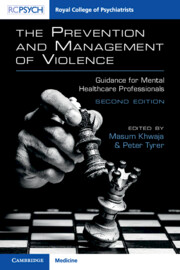Book contents
- The Prevention and Management of Violence
- The Prevention and Management of Violence
- Copyright page
- Dedication
- Contents
- Contributors
- Preface
- Abbreviations
- Section 1 General Aspects of Management
- Introduction to Section 1
- Chapter 1 The Need for a Common Set of Guidelines
- Chapter 2 Legislation Relevant to the Management of Violence by Persons With Mental Disorders
- Chapter 3 Protection and Safeguarding of Vulnerable Adults and Children Exposed to Violence
- Chapter 4 Anticipation and Reduction of Violence: Implications of the NICE 2015 Guideline
- Chapter 5 Post-Incident Management
- Section 2 Medical and Psychological Intervention
- Section 3 Violence in Different Settings
- Section 4 Management in Other Groups
- Section 5 Violence and Society
- Section 6 Engagement and Understanding
- Index
- References
Chapter 1 - The Need for a Common Set of Guidelines
from Section 1 - General Aspects of Management
Published online by Cambridge University Press: 09 May 2023
- The Prevention and Management of Violence
- The Prevention and Management of Violence
- Copyright page
- Dedication
- Contents
- Contributors
- Preface
- Abbreviations
- Section 1 General Aspects of Management
- Introduction to Section 1
- Chapter 1 The Need for a Common Set of Guidelines
- Chapter 2 Legislation Relevant to the Management of Violence by Persons With Mental Disorders
- Chapter 3 Protection and Safeguarding of Vulnerable Adults and Children Exposed to Violence
- Chapter 4 Anticipation and Reduction of Violence: Implications of the NICE 2015 Guideline
- Chapter 5 Post-Incident Management
- Section 2 Medical and Psychological Intervention
- Section 3 Violence in Different Settings
- Section 4 Management in Other Groups
- Section 5 Violence and Society
- Section 6 Engagement and Understanding
- Index
- References
Summary
Violence and aggression never present themselves in a vacuum, yet this is typically the way policymakers approach the subject, its prevention and its management. Although guidelines exist in different sectors, too often little or no consideration is given to many of the wider issues in play, particularly the use of restraint when it becomes necessary. Despite the long-standing call for a common set of guidelines, we are only now looking at the introduction of the Restraint Reduction Network training standards, and it seems that anything approaching a set of common guidelines that all settings can embrace is a long way off. The aim of any good guidance seeking to influence practices in the prevention and management of violence and aggression should be to minimise the need for any restrictive intervention but where necessary to apply techniques as safely as possible within the relevant legislative framework. Certain staff in healthcare settings need to receive training to increase the organisation’s capacity and capability to deal with potentially violent situations without recourse to external agencies, such as police, who operate to a different set of standards to those within healthcare settings and who use techniques that healthcare staff would not wish to see used in their settings.
Keywords
Information
- Type
- Chapter
- Information
- The Prevention and Management of ViolenceGuidance for Mental Healthcare Professionals, pp. 2 - 14Publisher: Cambridge University PressPrint publication year: 2023
